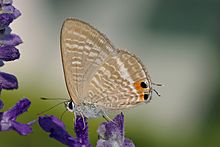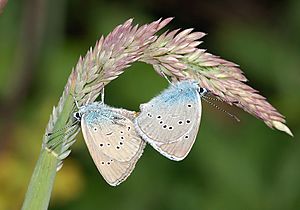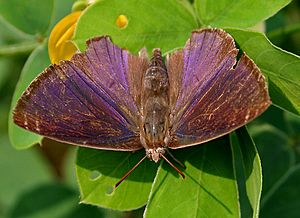Lycaenidae facts for kids
Quick facts for kids Lycaenidae |
|
|---|---|
 |
|
| Peablue Lampides boeticus |
|
| Scientific classification | |
| Kingdom: | |
| Phylum: | |
| Subphylum: | |
| Class: | |
| Order: | |
| Superfamily: | |
| (unranked): | |
| Family: |
Lycaenidae
|
The Lycaenidae are a huge family of butterflies, with about 6,000 different kinds found all over the world! People often call them gossamer-winged butterflies because their wings look so delicate and thin.
This family has many stunning butterflies. Sadly, some, like the Palos Verdes blue, are in danger of disappearing forever. A famous Russian writer and butterfly expert named Vladimir Nabokov loved these butterflies.
Contents
Lycaenidae and Ants
Lycaenid butterflies have many different ways of finding food. Most of them eat plants, but some are special. They eat other insects like aphids, scale insects, and even ant larvae!
About 75% of Lycaenid species have a close relationship with ants. This special connection is called myrmecophily. It can be helpful for both (mutualistic), or sometimes one benefits more than the other (parasitic or predatory).
How Butterflies and Ants Help Each Other
In some cases, ant "farm" the butterfly caterpillars. The ants protect the caterpillars from enemies while they eat plants. In return, the caterpillars give the ants a sweet liquid called honeydew. This happens throughout the caterpillar's life, and sometimes even when it becomes a pupa.
Other Lycaenid caterpillars spend only their first few stages on a plant. After that, they move into an ant nest! Inside the nest, they might become parasites, getting food from the ants. Or, they might become predators, eating the ant larvae.
The caterpillars even turn into pupae inside the ant nest. The ants continue to look after the pupae. Just before the adult butterfly comes out, its wings inside the pupa case become shiny. The adult butterfly emerges after about three to four weeks, still inside the ant nest. It then has to crawl out of the nest before it can spread its wings and fly.
Special Caterpillar Features
Lycaenid caterpillars have special body parts that help them connect with ants. They have tiny glands on their skin called "pore cupola organs." Many species also have a gland on their seventh body part that makes honeydew. This is called the "dorsal nectary gland."
They also have a "tentacular organ" on their eighth body part. This organ can pop out and has a ring of spikes. It releases chemical signals that are thought to help the caterpillars talk to the ants.
Types of Lycaenid Butterflies

Scientists group Lycaenid butterflies into several main subfamilies. These are like different branches of the same family tree.
Here are some of the main groups:
- Lipteninae (found in Africa)
- Poritiinae (found in Asia and Africa)
- Liphyrinae (mostly African, some Asian)
- Liphyra brassolis – This is the largest Lycaenid butterfly!
- Curetinae – These are called sunbeams.
- Miletinae – These are called harvesters. Many of them eat aphids or their sweet secretions.
- Curetis thetis – The Indian sunbeam.
- Theclinae – These are called hairstreaks (because they often have small tails on their wings) and elfins (which don't have tails). They are found all over the world.
- Arhopala - Oakblues
- Atlides halesus – The great purple hairstreak.
- Eumaeus atala – The Atala butterfly.
- Satyrium pruni – The black hairstreak.
- Lycaeninae – These are called coppers.
- Iophanus pyrrhias – The Guatemalan copper.
- Lycaena boldenarum – The boulder copper.
- Lycaena epixanthe – The bog copper.
- Lycaena rauparaha – Rauparaha's copper.
- Lycaena dispar – The large copper.
- Lycaena phlaeas – The small copper.
- Lycaena heteronea - The blue copper.
- Polyommatinae – These are called blues. They are found all over the world.
- Caleta species.
- Celastrina ladon – The spring azure.
- Chilades - Jewel blues.
- Cupido comyntas – The eastern tailed-blue.
- Cupido minimus – The small blue.
- Euphilotes battoides allyni – The El Segundo blue.
- Euphilotes pallescens arenamontana – The Sand Mountain blue.
- Glaucopsyche lygdamus – The silvery blue.
- Glaucopsyche lygdamus palosverdesensis – The Palos Verdes blue.
- Glaucopsyche xerces (extinct) – The Xerces blue.
- Icaricia icarioides fenderi – Fender's blue.
- Maculinea arion – The large blue.
- Phengaris xiushani
- Polyommatus icarus – The common blue.
- Polyommatus semiargus – The mazarine blue.
- Pseudozizeeria maha – The pale grass blue.
- Plebejus argus – The silver-studded blue.
- Talicada nyseus – The red pierrot.
See also
 In Spanish: Licénidos para niños
In Spanish: Licénidos para niños




